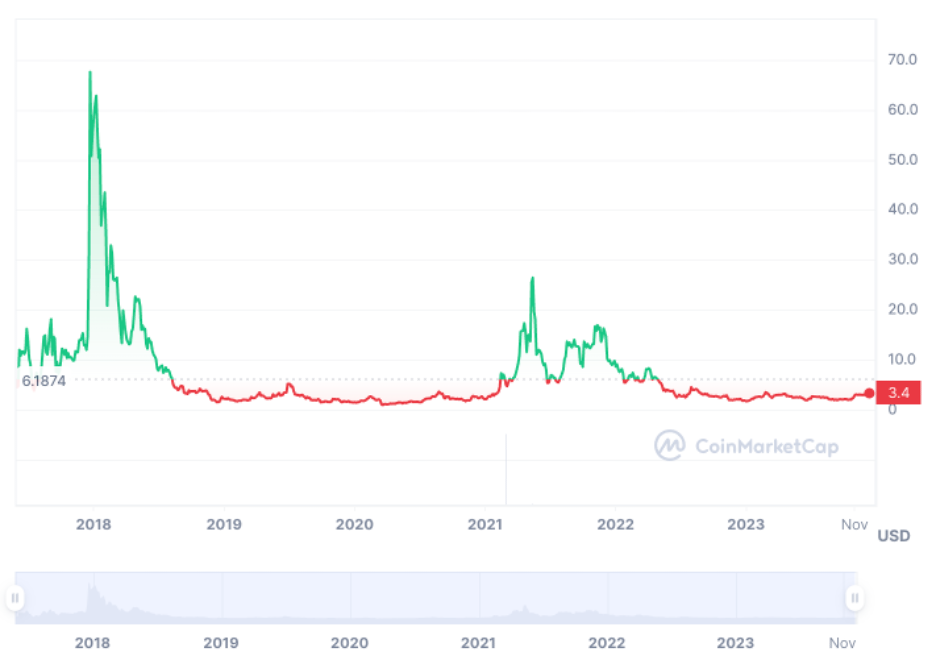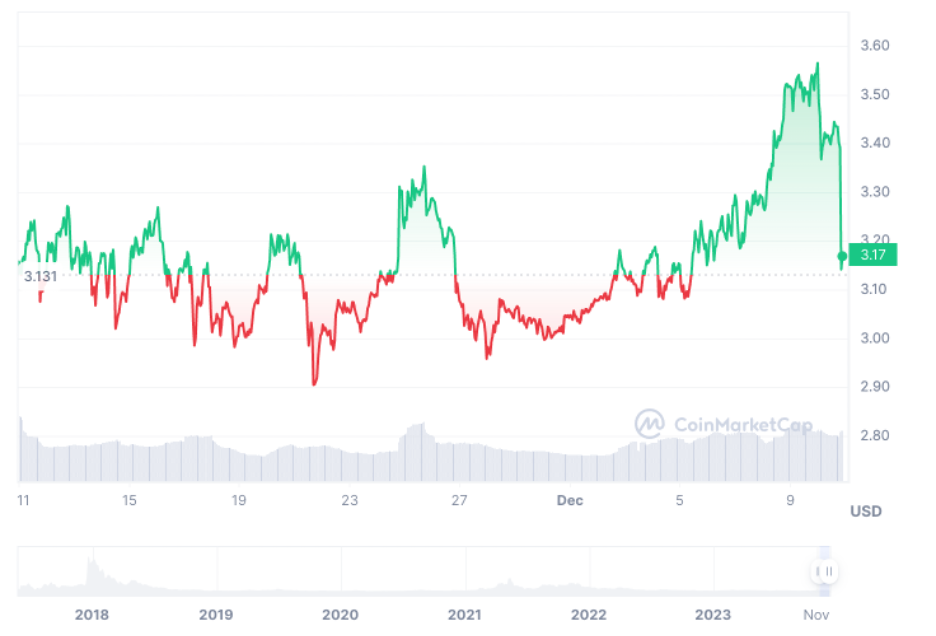Qtum: Bridging Bitcoin’s Security with Ethereum’s Versatility
By Yvonne Zhang | Crescent City Capital Market Analyst Intern

What Is Holo (HOT)?
Qtum, pronounced as “quantum,” is a distinctive blockchain platform that ingeniously merges the features of Bitcoin and Ethereum, offering a hybrid solution in the blockchain space. At its core, Qtum utilizes Bitcoin’s Unspent Transaction Output (UTXO) transaction model, renowned for its robust security and stability, and ingeniously integrates it with Ethereum’s smart contract and decentralized application (DApp) functionality. This amalgamation enables the development and execution of complex DApps and smart contracts on a platform that enjoys the proven security features of Bitcoin’s blockchain architecture.
What Makes Qtum Unique?
In contrast to Bitcoin’s energy-intensive proof-of-work (PoW) system, Qtum operates on a proof-of-stake (PoS) consensus mechanism, which not only reduces the environmental footprint but also democratizes the participation process by allowing individual coin holders to stake their tokens to validate transactions and maintain network security. One of the standout features of Qtum is its Account Abstraction Layer (AAL), which facilitates the integration of the UTXO model with the smart contract capabilities inspired by Ethereum. This unique feature enables the execution of Ethereum-style smart contracts on Qtum’s Bitcoin-based blockchain, offering developers a versatile and robust platform for building applications.
Furthermore, Qtum introduces a Decentralized Governance Protocol (DGP), allowing for certain blockchain parameters, like block size and gas fees, to be adjusted without necessitating a hard fork. This protocol significantly enhances the platform’s flexibility and adaptability, ensuring it can evolve over time to meet changing needs and circumstances. Qtum’s compatibility with multiple programming languages, including C, C++, Rust, and Python, through its x86 virtual machine, further underscores its developer-friendly approach. This language support broadens the scope for developers, enabling them to leverage existing skills and resources to create and deploy a wide range of applications on the Qtum platform.
Overall, Qtum stands out in the blockchain ecosystem for its innovative fusion of Bitcoin’s reliability with Ethereum’s functionality, offering a unique, versatile, and secure platform for both developers and users in the blockchain space.
Key Features of MPoS in Qtum
Staking Incentive: MPoS incentivizes users to participate in the network’s security by ‘staking’ their coins. This process involves locking coins in the network, which then facilitates and secures block validation. Users who stake their coins are in essence participating in maintaining the network’s integrity.
Block Validation Process: In the Qtum network, the right to validate a block is determined through a competitive process among coin holders. This competition is based on their connectivity to the network and an element of random chance. Unlike earlier PoS systems, the block reward in Qtum’s MPoS does not depend on the ‘age’ of the staked coins, but rather on the quantity of the stake. This means the more coins a user stakes, the higher their potential reward.
Reward Distribution: One of the defining aspects of Qtum’s MPoS is how it distributes block rewards. It splits 10% of the block reward between the miner who produced the current block and the miners of the nine previous blocks. This system aims to prevent “junk contract” attacks and promotes a more equitable distribution of rewards among participants. Furthermore, to enhance stability and security, 90% of the block reward is delayed and distributed over the next 500 blocks.
Environmental and Cost Benefits: By adopting a proof-of-stake mechanism, Qtum significantly reduces the environmental impact and maintenance costs associated with proof-of-work systems like Bitcoin’s. PoS algorithms require far less computational power, leading to lower energy consumption and a smaller carbon footprint.
Decentralization: One of the cornerstones of blockchain security is decentralization, and Qtum’s MPoS mechanism fosters this by allowing a broader range of participants to engage in network validation processes. This decentralization is not only democratic but also adds to the robustness and security of the network, as it avoids centralizing power in the hands of a few large miners or groups.
Recent Updates
The live Qtum price on Dec 10th is $3.20 USD with a 24-hour trading volume of $65,476,744 USD. Qtum is down 8.96% in the last 24 hours. The current CoinMarketCap ranking is #134, with a live market cap of $334,713,692 USD. It has a circulating supply of 104,755,842 QTUM coins and a max. supply of 107,822,406 QTUM coins.

Examining the provided screenshot, it’s evident that Qtum has experienced a 46.30% decline since its inception. Its peak value was $106.88, achieved over six years ago. A glance at the subsequent screenshot reveals that in the past month, Qtum has shown a modest revival, climbing by 4.62% since early November.
Initially, when Qtum was launched, it garnered significant interest due to its hybrid technology that amalgamates the strengths of Bitcoin and Ethereum. This novelty attracted a substantial number of investors to Qtum. Unlike many cryptocurrencies, Qtum’s price dynamics appear to be less influenced by Bitcoin’s market movements.

On April 30, 2021, the FastLane hard fork in the Qtum blockchain was implemented. This update significantly reduced the block time, from 128 seconds to 32 seconds, and decreased the block reward to one QTUM. Owing to its faster blockchain than Bitcoin, Qtum’s halving schedule is distinct from that of Bitcoin’s.
The first halving on the QTUM blockchain occurred at block 1,427,004 on December 1, as reported by the official website. This event slashed the block rewards from 1.0 QTUM every 32 seconds to 0.5 QTUM, adjusting the coin’s annual inflation rate to approximately 0.5%.
In November 2021, Qtum announced details of its rebranding and disclosed plans to amplify its marketing efforts in 2022. This strategic enhancement in Qtum’s technology elevate its value between 2021 and 2022.

However, throughout the current year, Qtum’s price has seen fluctuations, hovering around $2.75. With the recent overall surge in the cryptocurrency market, Qtum’s value has shown an uptrend compared to its performance earlier in the year. Although the price is nearing the mid-point of the month, it might be advisable to consider purchasing Qtum if it reaches around $2.85.
If Qtum continues to leverage its innovative blend of Bitcoin’s robust security and Ethereum’s smart contract functionality, it could see increased adoption and appreciation in value. The platform’s Account Abstraction Layer (AAL) and Decentralized Governance Protocol (DGP) position it as a flexible and adaptable blockchain solution, potentially attracting a diverse range of developers and enterprises. Additionally, Qtum’s commitment to energy-efficient consensus via its proof-of-stake (PoS) mechanism aligns well with the growing emphasis on sustainability in the tech sector. If these strengths are coupled with a favorable market environment and wider acceptance of cryptocurrencies, Qtum could experience a positive trend in both adoption and market value.
Reference:
https://coinmarketcap.com/currencies/qtum/
https://www.cryptoeq.io/corereports/qtum-abridged
https://facts.net/science/technology/11-mind-blowing-facts-about-qtum-qtum/
https://themerkle.com/what-is-qtum/

